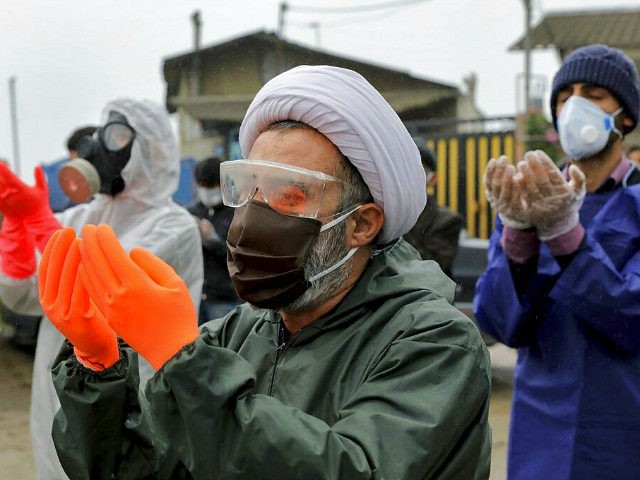The National Council of Resistance of Iran (NCRI) announced on Tuesday that, by its tally, over 41,000 people have died in Iran as a result of Chinese coronavirus infection. The death toll surpassed 40,000 on Friday.
The NCRI keeps an independent tally of coronavirus deaths in the country in concert with its affiliated dissident groups, the People’s Mojahedin Organization of Iran (PMOI/MEK), which uses a combination of local confirmed cases and deaths and information from medical staff at major hospitals to keep track. The death rate the group has documented is significantly higher than official Iranian Islamic regime estimates.
Officially, Iran claims to have confirmed 110,767 cases of Chinese coronavirus in the country and 6,733 deaths, which still makes it one of the most severely affected nations by the pandemic.
PMOI/MEK noted in its update of its internal tally that the Iranian regime death toll is less than one-seventh of what the dissident group alleges it is. The tally cites both local counts in some of the most affected provinces and individual death counts in hospitals with large numbers of people affected.
In announcing the updated number, the dissident organization also cited reports in government-run media – Iran only allows official state publications or nominally private but regime-friendly media groups to operate in the country – that indicate few within Iran believe the official numbers.
One state-run newspaper, Jahane San’at, allegedly published a report on Tuesday stating that the official numbers have been deflated in large part by Iranian government officials ordering hospitals not to take coronavirus patients in anymore.
“In many cities, they are no longer taking COVID-19 patients to hospitals. They refuse to provide medical treatment for so long that the patient dies and is directly taken to a cemetery,” the newspaper reported, according to the PMOI/MEK.
The dissident group also cited other media outlets expressing alarm at how the economic crisis is creating high-risk situations for coronavirus contamination. One newspaper reported an increase in the number of people scavenging through trash for items they could use to sell and trade for food, a situation reminiscent of that which has dominated the streets of cities of Venezuela, an Iranian regime ally, for years.
The surge in cases this week comes accompanied by Iranian regime policies to ease social distancing restrictions. On Tuesday, the regime reopened the nation’s mosques, a point of contention between Health Ministry officials and the powerful radical clerics that the regime largely answers to. Health experts believe the outbreak originally exacerbated through the crowding of Islamic sites in the holy city of Qom. Despite attempting to shut down religious sites to prevent crowding in the early days of the outbreak in March, imams openly urged the faithful to defy the bans and flood shrines across the country.
As it is currently Ramadan, the holiest month on the Islamic calendar, Ayatollah Ali Khamenei allowed for the reopening of mosques. Iran is also scheduled to reopen schools next week.
Khamenei, the supreme leader of the country, demanded last week that Iranian businesses start a “jump in production” to fight “manufactured viruses such as sanctions,” referring to American sanctions on Iran over its illegal nuclear weapons development.
“Should we want to liken the economy to human body, the defense system that provides the economy with security would be production. In other words, the element that can neutralize invasive viruses and microbes targeting the economy and keep it healthy is production,” Khamenei explained.
When not boasting of its success in containing the virus, the Iranian regime has blamed others for its failures. Notably, Health Ministry officials have not shied away from blaming the Communist Party of China, an allied regime to Iran, for its efforts to censor key information about the Chinese coronavirus prior to its localized outbreak becoming a pandemic.
“It seems statistics from China was a bitter joke because many in the world thought this is just like influenza, with fewer deaths. This [impression] were based on reports from China and now it seems China made a bitter joke with the rest of the world,” Health Ministry spokesman Kianush Jahanpur said last month.
Last week, health officials openly admitted that the rate of infection had not reduced to a level that made the resumption of normal life safe.
“What we expected regarding a faster decrease in numbers has not materialized. In some provinces we are actually witnessing a significant rise in our stats,” Iranian Deputy Health Minister Iraj Harirchi said on state television last week, according to PMOI/MEK. Harirchi himself became the object of international attention in February when he appeared on television, sweating and feverish, claiming that Tehran had the outbreak under control. He tested positive for the Chinese coronavirus shortly after that appearance but seems to have recovered since then.
Iranian officials have remained upbeat about the nation’s response to the pandemic despite the increasingly dire numbers. Last week, Health Minister Saeed Namaki asserted definitively that Iran had “outperformed the most powerful countries in the fight against coronavirus.” He made the statement on Twitter, not citing any particular statistics to support his claim.

COMMENTS
Please let us know if you're having issues with commenting.